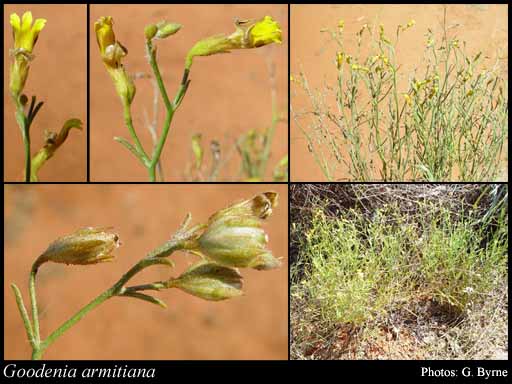- Reference
- Fragm. (Mueller) 10:110-111 (1877)
- Conservation Code
- Not threatened
- Naturalised Status
- Native to Western Australia
- Name Status
- Current
Erect, densely tufted perennial, herb, 0.15-0.5 m high. Fl. yellow, Mar to Nov. Sandy soils.

Scientific Description
Stems ribbed or unribbed. Leaves compressed or flat, 10-35 mm long, 0.5-2 mm wide, Indumentum present, with sparse, simple hairs; margins entire. Bracteoles absent. Pedicel pedicellate, Pedicel length the pedicels 3-13 mm long, Indumentum present, Hair type with simple hairs. Calyx lobes present, Calyx length 2.5-3.5 mm long, hairy, with sparse, glandular hairs. Corolla yellow, 9.5-15 mm long, auriculate, not spurred, glabrous on the outside, glandular hairs, glabrous on the inside; central lobes 2.5-5 mm long, with wings, 0.5-1 mm wide; outer lobes 5-6 mm long, wing present on both sides and clearly unequal, 0.2-0.4 mm wide on the narrower side, 0.4-1.2 mm wide on the broader side. Anthers free. Ovary inferior, not gibbose; style 5-5.5 mm long, hairy; indusium single, hairy; ovules more than two. Flowers in March, April, May, June, July, August, September, October and November. Occurs in the Pilbara (PIL), Great Sandy Desert (GSD), Little Sandy Desert(LSD), Dampier land (DL) and Ord-Victoria Plains (OVP) IBRA Region(s), of the Northern (N) and Eremaean (E) Botanical Province.
Distribution
- IBRA Regions
- Central Kimberley, Dampierland, Great Sandy Desert, Little Sandy Desert, Northern Kimberley, Ord Victoria Plain, Pilbara, Tanami, Victoria Bonaparte.
- IBRA Subregions
- Chichester, Fitzroy Trough, Fortescue, Hart, Keep, Mackay, McLarty, Mitchell, Mount Eliza, Pentecost, Pindanland, Purnululu, Roebourne, Rudall, South Kimberley Interzone, Tanami Desert, Trainor.
- IMCRA Regions
- Cambridge-Bonaparte, Canning.
- Local Government Areas (LGAs)
- Ashburton, Broome, Derby-West Kimberley, East Pilbara, Halls Creek, Karratha, Port Hedland, Wyndham-East Kimberley.